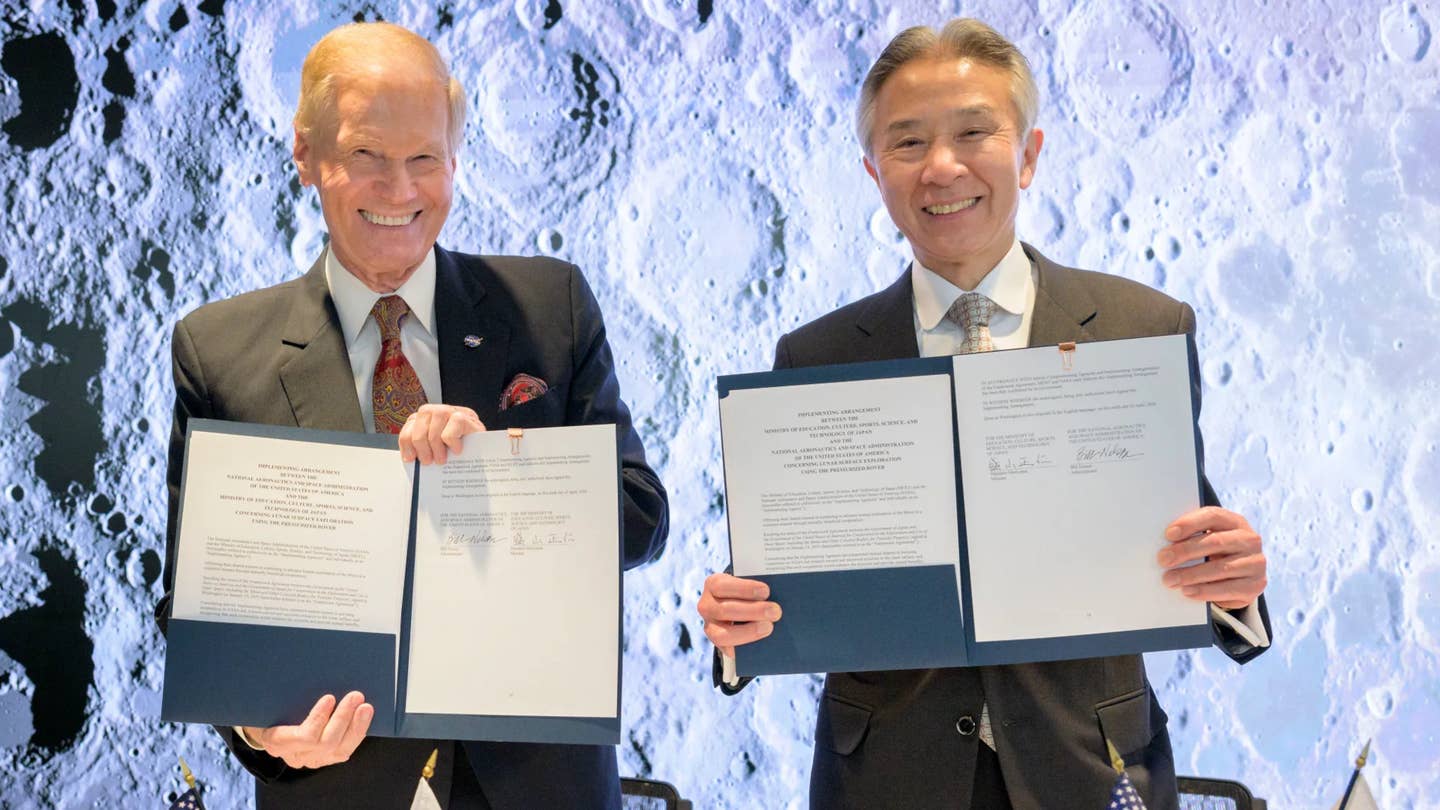U.S., Japan Expand Space Collaboration with Lunar Rover Agreement
The crewed, pressurized lunar rover will give astronauts more time to conduct experiments on the moon and the ability to travel farther than ever before.

NASA Administrator Bill Nelson signs an agreement with Masahito Moriyama, Japan’s minister of education, culture, sports, science and technology. [Courtesy: NASA]
The U.S. and Japan on Wednesday signed a quid-pro-quo agreement to give both countries’ space exploration initiatives a boost.
NASA and the Japan Aerospace Exploration Agency (JAXA) have agreed to facilitate missions to the moon using a crewed lunar rover designed, built, and operated by Japan. The enclosed and pressurized rover is designed to serve as a mobile habitat and laboratory for human personnel.
In exchange, NASA will set aside space for two JAXA astronauts on future moon landing missions under its Artemis program. Artemis is essentially the successor to the Apollo program, with the aim of initiating a new generation of lunar exploration.
NASA expects the rover, which will give crews more time to work on the lunar surface, to land on the moon during the Artemis VII mission, which is tentatively scheduled for 2030 or 2031. The agency anticipates it will have a 10-year lifespan and be used on subsequent Artemis missions. Japan will design, develop, and operate the rover, while NASA will provide launch and delivery to the moon.
“America no longer will walk on the Moon alone,” said NASA Administrator Bill Nelson. “With this new rover, we will uncover groundbreaking discoveries on the lunar surface that will benefit humanity and inspire the Artemis generation.”
Nelson and Masahito Moriyama, Japan’s minister of education, culture, sports, science and technology, signed the agreement Tuesday at NASA Headquarters in Washington, D.C.
The following day, President Joe Biden and Japanese Prime Minister Fumio Kishida announced “a shared goal for a Japanese national to be the first non-American astronaut to land on the moon on a future Artemis mission, assuming important benchmarks are achieved.”
A crewed, pressurized rover called the Lunar Cruiser has been under development by JAXA and Toyota since 2020. The vehicle uses hydrogen fuel cell technology found in the automaker’s electric vehicles. It could transport astronauts across the lunar surface for up to 30 days and cruise for up to 6,200 miles, providing ample time to perform research and conduct experiments. The partners are further developing systems to automate most of the driving and navigation.
The Lunar Cruiser’s tires are made from metal, and an onboard fuel cell uses solar energy and stored water to produce hydrogen and oxygen, generating electricity. The rover can also convert electricity stored in its battery pack back into hydrogen and oxygen.
According to NASA, two astronauts will use the vehicle to traverse the moon’s south pole during Artemis VII. Toyota expects it to be ready for launch by 2029.
“The pressurized rover will be a powerful contribution to the overall Artemis architecture as Japan and the U.S. go hand in hand with international and industry partners to the lunar surface and beyond,” said JAXA president Hiroshi Yamakawa.
The lunar rover arrangement falls under a framework agreement signed between the U.S. and Japan in 2023, which signifies the countries’ “mutual interest in peaceful exploration.”
The agreement covers a wide range of activities from science to exploration and will include Japanese participation in NASA’s Dragonfly mission, which will study Saturn’s largest moon, called Titan, using a dual-quadcopter lander. JAXA will also contribute to the development of NASA’s Nancy Grace Roman Space Telescope. In return, NASA will help develop JAXA’s SOLAR-C sun-observing satellite.
The U.S. space agency will allocate crew space for a JAXA astronaut on a future Artemis mission to deploy Gateway, a lunar orbital space station. An agreement between the two calls for Japan to supply the space station’s environmental control and life support systems and cargo transportation.
Artemis I—an uncrewed lunar flight test of NASA’s Space Launch System and Orion capsule—splashed down in December 2022 after a 25-day, 1.4 million-mile jaunt around the moon and back. However, issues unearthed during the flight have delayed Artemis II, a crewed lunar flyby, and Artemis III, intended to be the first crewed lunar landing in half a century, to September 2025 and 2026, respectively.
Artemis III astronauts would become the first humans to visit the moon’s south pole, where they will collect lunar samples, images, and other data. NASA describes the mission as “one of the most complex undertakings of engineering and human ingenuity in the history of deep space exploration.”
Like this story? We think you'll also like the Future of FLYING newsletter sent every Thursday afternoon. Sign up now.

Subscribe to Our Newsletter
Get the latest FLYING stories delivered directly to your inbox






